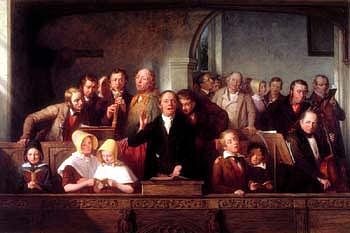 Between 1720 and 1770 the singing-school movement grew tremendously. As the skills of the students grew, so did the call for more difficult and interesting music, especially music that could be sung by the meeting-house choirs that had developed out of the singing-school phenomenon. This gap was filled in part by music from the so called "West Gallery" movement back in Britain which persisted well into the 19th century. The same need to improve singing that had begun in the colonies had begun in the English parish churches a bit earlier and singing schools met the need there as well. The term "West Gallery" came from the practice of building a gallery in the west end of a parish church to accommodate the newly-formed choirs and is aptly depicted in The Village Choir (right) by Thomas Webster (1800-1886). William Tans'ur, one of the leading composers to supply this movement, published several collections of vocal music with instructions for reading music. His A Compleat Melody (1735) became well known in the colonies in its British printing. In the preface to this work Tans'ur suggests that the great composers of his day (Handel perhaps?) were too busy with grander pursuits to write for the lowly parish church:
Between 1720 and 1770 the singing-school movement grew tremendously. As the skills of the students grew, so did the call for more difficult and interesting music, especially music that could be sung by the meeting-house choirs that had developed out of the singing-school phenomenon. This gap was filled in part by music from the so called "West Gallery" movement back in Britain which persisted well into the 19th century. The same need to improve singing that had begun in the colonies had begun in the English parish churches a bit earlier and singing schools met the need there as well. The term "West Gallery" came from the practice of building a gallery in the west end of a parish church to accommodate the newly-formed choirs and is aptly depicted in The Village Choir (right) by Thomas Webster (1800-1886). William Tans'ur, one of the leading composers to supply this movement, published several collections of vocal music with instructions for reading music. His A Compleat Melody (1735) became well known in the colonies in its British printing. In the preface to this work Tans'ur suggests that the great composers of his day (Handel perhaps?) were too busy with grander pursuits to write for the lowly parish church:
"I will confess that our nation is at this time well stored with good and learned musicians who are doubtless better able to have undertaken this work than myself. But alas! They are most of them (if not all) too busy in plays, operas, etc. than to do anything to the Praise of God; nor yet seem to have any regard to encourage such
to do. Vide Proverbs 29:26 [Then said I, Wisdom is better than strength; nevertheless the poor man's wisdom is despised, and his words are not heard. KJV], and Ecclesiastes 9:16. [Man seeks the ruler's favour; but every man's judgment cometh from the Lord. KJV]"
Besides Tans'ur, other composers like William Knapp, Joseph Stephenson, and Aaron Williams wrote and published Psalm tunes, fuging tunes (short homophonic section followed by an imitative section like PSALM 34) and anthems for the English parish choirs. Colonial entrepreneur and opportunist Daniel Bayley reprinted Tans'ur's and William's collections under the title American Harmony in 1769. Simeon Jocelin, Josiah Flagg, Andrew Law,and James Lyon also reprinted English gallery music in their American publications. Gallery music was the model for later American composers like William Billings and Daniel Read.